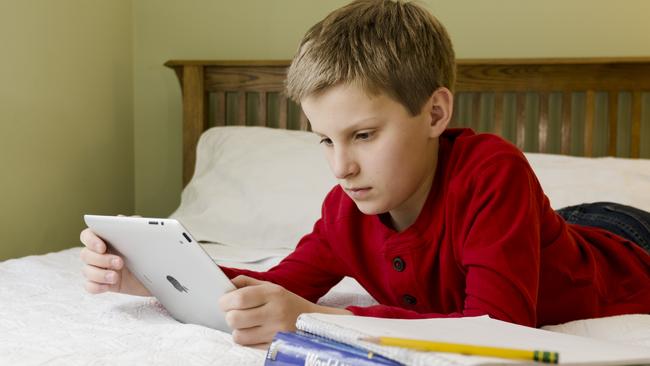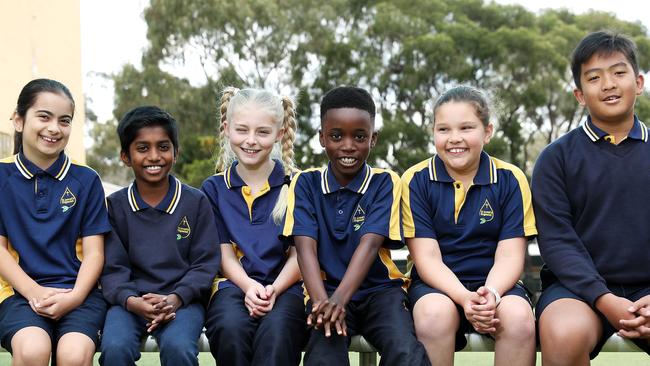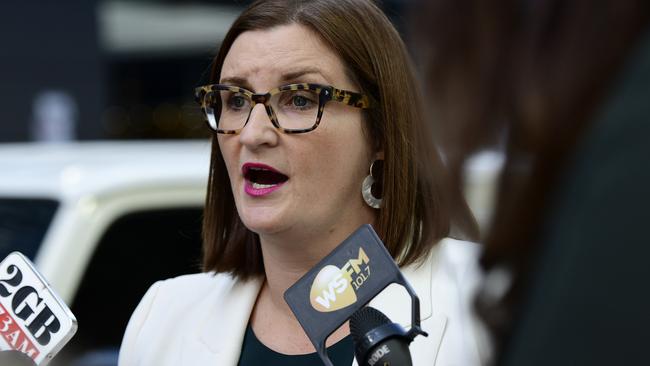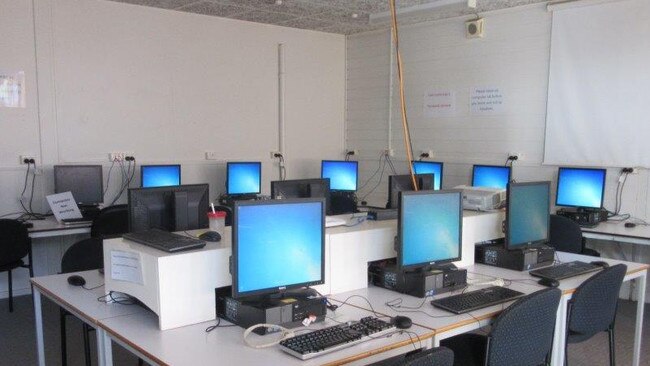Generation that grew up with iPads and computers scores poor Year 7 results
NSW Year 7 students have recorded one of their worst performances in NAPLAN since it began.
NSW
Don't miss out on the headlines from NSW. Followed categories will be added to My News.
- Opinion: NAPLAN failure is on parents
- Static results trigger rethink on NAPLAN test
- Good money wasted on bad results
NSW Year 7 students have recorded one of their worst performances in NAPLAN since it began.
Results in every subject except spelling are down from where the start of the decade, with the percentage of students reaching the minimum standard in reading, writing, grammar and punctuation all down.
This year’s Year 7 students have grown up with ubiquitous iPads and computers in classrooms.

For writing, a quarter of Year 7 students scores were either below the minimum or just above.
The latest data shows 8.3 per cent of kids were below the standard and 18.4 just scraped by.
For grammar and punctuation, 19.5 per cent of students either didn’t make the grade or got the lowest grade possible to just scrape by.
University of Sydney cognitive psychology Prof Sally Andrews said this could go some way to explaining why grammar and punctuation skills had slipped.
“Because of the nature of the goals of the reader, whether in the classroom or their own reading, that sort of skimming strategy will reduce children’s sensitivity to punctuation and typical grammatical structures,” she said.
“All of the changes in attention that has accompanied (screens) have changed the ways in which people read.
“That means that they’re not picking up on the subtleties of sentence construction and punctuation marks that occur when you read a book on paper.”
YEAR 3 RESULTS
Year 3 students were the NSW success story in this year’s NAPLAN testing, topping the country in every subject area.
The cohort also improved on previous results by their peers last year in numeracy, writing, grammar and punctuation, and reading.
A whopping 98.8 per cent of students achieved at or above the national minimum standard in writing, while the lowest area was spelling with 95 per cent of students achieving the standard.
Director of SIGI Learners — a Sydney-based tutoring company — said the positive year three results were a credit to both teachers and students.
“One of the reasons why I think we see improvement in year 3 kids is at the end of the day it’s easier for them to process information,” he said.

“They probably respond better to authority and discipline than the older students.”
Despite the success of younger students, NSW Education Minister Sarah Mitchell says there is “work to do” in our high schools following disappointing NAPLAN results for higher grades.
Testing revealed students are performing worse in reading and writing than they were a decade ago.
Ms Mitchell said the rollout of “outcomes based funding” for schools announced earlier this year would make sure taxpayers are getting bang for their buck from schools teaching literacy and numeracy.
“For us in NSW we have seen consistent results in our primary schools which is encouraging, but clearly there are indications there (is) work to do within our high schools,” she said.
“We also announced this year that we will be looking at outcomes based budgeting for education, we’re the first cluster that will be doing that in the state.
“That’s about making sure every dollar that is going in is going toward improving student outcomes … What I want to see as minister is a lift in results over time.”
While she said she supported standardised testing, the technical bungles with NAPLAN which saw the website crash this year and students were able to access spell check and Google to check answers raised serious questions about the current state of the test.
NSW joined Queensland and Victoria earlier in the year going rogue to conduct their own review of the NAPLAN test.
“We need to look at all elements of the test, make sure that it is assessing what it should, make sure it is linked to the curriculum, that it is useful data for teachers and policymakers and that it is showing student growth,” she said.
RELATED NEWS
Tech glitches force 50,000 NAPLAN re-sits
NAPLAN only useful if it makes us better
Teachers reveal hidden NAPLAN truths
Results released today show NSW students are worse at grammar and punctuation than their peers were a decade ago as experts warn “autocorrect” typing tools and skim reading on digital screens are to blame for a slump in NAPLAN test results.
Fewer children in Years 5, 7 and 9 achieved the minimum national standard for grammar and punctuation this year compared to in 2008 when testing began, despite an increase in education spending per student in that time.

Teachers reveal hidden NAPLAN truths
According to preliminary NAPLAN results released on Wednesday, NSW Year 9 reading scores also dropped compared to a decade ago, while Year 7 students results were worse in every subject except spelling.
About 90.8 per cent of Year 9 students achieved at or above minimum standard for grammar and punctuation — successfully answering questions about where to place an apostrophe or speech marks — down from 93.3 per cent last year and 91.4 per cent in 2008.
The stagnating results come as spending on government schools increased per student overall.
Analysis by the Grattan Institute found effective funding per student to government schools increased by 4 per cent in the decade to 2016-17 to $16,023 a year.
While spending is estimated to have increased by a further $430 per student in the last two years due to extra state and commonwealth funding under the Gonski model.
University of Sydney cognitive psychology professor Sally Andrews said students’ poorer grammar skills could be the result of an increase in “skim reading” on screens.
“That means that they’re not picking up on the subtleties of sentence construction and punctuation marks that occur when you read a book on paper,” she said.
“Because of the nature of the goals of the reader, whether in the classroom or their own reading, that sort of skimming strategy will reduce children’s sensitivity to punctuation and typical grammatical structures.”

Director of SIGI Learners — a Sydney-based tutoring company — Scott Yung said using “autocorrect” functions when typing also impacted on writing skills.
“These days you don’t need a fancy device or program to have autocorrect, it’s in Microsoft and every smartphone,” he said.
“Your brain is less proactive about making word and grammar choices if your writing is automatically being fixed.”
Mr Yung said he believed the curriculum over-relied on students picking up grammar skills by reading.
“There’s not enough emphasis on grammar and punctuation,” he said.
“A lot of parents share with us their concerns that their child is just expected to pick up those skills through reading rather than specifically learning them in a dedicated class.”
Australian Catholic University education expert Professor Kevin Donnelly said students were not getting enough explicit instruction for reading, grammar and punctuation because the NSW curriculum had become crowded with politically correct clutter.
“There is too much focus on the cross-curriculum priorities, whether it is indigenous history and culture or study of Asia or sustainability in the environment,” he said.
“There is too much emphasis on those three and it just makes it harder for teachers to focus on what is essential and what they really should be doing.”
The NSW English Curriculum was updated in 2012 with an increased focus on grammar.
But Centre for Independent Studies Education Research Fellow Blaise Joseph said over time the mechanics of English language teaching had become “less rigorous”.

“There is an inconsistency with how grammar and punctuation are taught — going through and teaching them explicitly … arguably occurs less now than when it used to be,” he said.
Year 3 students this year punched above their weight, topping the country in all five subject areas and improving on the percentage of students who achieved at or above the minimum standard compared to 10 years ago.
Education Minister Dan Tehan praised the Year 3 results but acknowledged there was still “room to improve,” particularly in the high school years.
“Our Government continues to support the principle of NAPLAN because we believe that parents and teachers want to see how students are progressing across their time at school and against a national measure,” he said.
“It is a crucial tool for parents to understand how their child is progressing in their education and where they might need more support.”
Labor’s education spokeswoman Tanya Plibersek said it was “no surprise” some NAPLAN results had declined when the marks needed to get into teaching were falling and schools were being “starved of support” under the Federal Government.
“Our hardworking teachers are being asked to do more with less,” she said.

Ms Plibersek said Australian kids needed to “know the basics”.
“It’s the foundation of the rest of their education. We can’t afford for the next generation to be held back.”
St Joseph’s Primary School in Kingswood have lifted their literacy results in NAPLAN thanks to dedicated instructional leaders, funded by the NSW Government’s Literacy and Numeracy Action Plan.
The school has had instructional teachers for the past two and a half years and over that time there has been a decrease in the number of vulnerable students in literacy and numeracy.
“We have had proven success, our improvement in our NAPLAN results and our other assessment data results over the last few years have proven that the model has worked,” the school’s assistant principal Lisa Howell said.
In addition, the school is bolstering literacy by promoting “reading stamina” this year.
“We are really focusing on students being able to maintain reading for longer periods of time.”
As part of the program Kindergarten to Year 6 students are encouraged to read every day and children’s authors visit the school.
YEAR 3 TEST
YEAR 5 TEST
YEAR 7 TEST
YEAR 9 TEST
